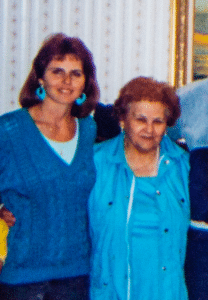 THE SCARS WE CAN HEAL Artist Rhonda Shelford Jansen
THE SCARS WE CAN HEAL Artist Rhonda Shelford Jansen
For Rhonda Shelford Jansen, what she paints is all about why. Her grandmother Lydia Resoff Shelford was a painter, and when she noticed the child had a love for sketching and doodling, Grandma began teaching her to paint, always directing her to take inspiration from reality: still life, images, photographs. But as she grew older, Rhonda realized that what she wasn’t painting was their culture. As she transitioned into a full-time career as an artist, Rhonda’s body of work developed around a discernable theme: Alaska Native people playing, subsisting, and simply existing amidst the natural world – sometimes joyful, sometimes serious.
“The reason I started painting Native culture,” Rhonda tells us, “is because of my grandma. She was born in 1912, and she had many scars from being treated poorly, had a lot of shame in her. And remembering it breaks my heart. Even my dad has scars, particularly living in the Lower 48, and they were not treated well. I’m farther down the line. I don’t have those same kinds of hurts, but [I feel their pain while] hearing my grandma talk and trying to coax her into pride for her heritage and into love for it. I paint for her, to honor her and to show her all this beauty, all the resilience, the creativity, ingenuity, all the amazing things that our ancestors and other Native peoples contributed that is just profound.”
While Rhonda was growing up, her family lived in several places around Alaska, including Unalaska and Kodiak. When they moved to Homer, Grandma booked Rhonda for lessons with renowned local artist Toby Tyler. Little did they know, Mr. Tyler was about to change the course of Rhonda’s life.
“Toby would say, ‘Today, we’re gonna paint a house, a red house, etc.,’” Rhonda says. “So, it was from my brain, not reproducing an image. It was painting from my imagination.”
As Rhonda got older – and better – Grandma drove her all over Kenai to art shows, where the young painter learned to compete and win ribbons. While Grandma was her first art teacher, she also taught Rhonda to not be afraid to put art out in the world. She said, “So many of us are afraid to fail, but none of us are good when we start out.”
Today, about 85% of what Rhonda paints starts as an idea in her head, then she does research, then sketches, then sketches on canvas. At that point, she may do more research and edit the sketch. Finally, she begins to paint.
Once a painting is complete, Rhonda leaves it for a couple days on the easel, then returns to look at it with fresh eyes and makes any adjustments she feels it needs.
Rhonda primarily works in her home studio, but during summer, she paints outdoors as much as possible, sketching scenic views along Turnagain Arm, for example. But more than anything, Rhonda likes to paint Alaska Native people. She depicts all cultures, not just her own Unangax̂ culture, which is why the research is so important to her. She works hard to get everything right, from clothing to kayak oars. “Especially at the beginning,” she tells us, “a lot of my paintings included water. We have a long family history in fishing, since at least the 1920s. The Dutch Harbor dock is named after my Uncle Bob. I love to paint boats, and I return to water whenever I can. When I lived in Dutch, there wasn’t a bridge, and I had to take a boat to school. We lived right on the water … I love hiking the hills to sit up there, and you can see water on all sides, and I would just sit up there and let my mind wander, and I would just stare at the absolute beauty.”
Rhonda’s grandmother passed away in 1999, so she never got to see the accomplished artist Rhonda has become. “I so wish that she was watching me paint, could see the good that I’m trying to demonstrate, the pride and how much there is to be proud of,” she tells us.
“I hope, one day, my art lasts and that it makes a difference that, in years to come, people can see it, and it will speak to the beauty of the cultures for a long time. That’s my mission.”
When asked if she has advice for her fellow shareholders, Rhonda says, “Overcoming fear of rejection is still my biggest obstacle. I would tell people to be proud of your gifts and your talents, even if you’re a fledgling (which most of us are). Dang it, go for it! We keep culture alive by doing that.
“I just wish my grandma could have lived to see the revitalization of Native peoples and cultures. Native people, we have a creative bend that needs to be set free and not be hindered by walls or fears. Go for it! You’re good enough, and you’re important.”
You can view Rhonda’s work at RhondaShelfordJansenArt.com or RSJArtist.com



